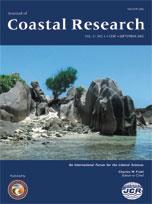In order to probe anisotropy of magnetic susceptibility (AMS) characteristics of tide-influenced sediments, AMS analyses and primary sedimentary structure observation and description were conducted on the borehole CM-97 samples from Changjiang delta, China. Primary sedimentary structure (cross-laminations) observation and description were based on a detailed examination of X-ray photographs of samples. Primary cross-laminations were found on 19 of 35 subcores, among which five subcores, A6, A7, B17, B30, and B38, have bidirectional cross-laminations. We found a total of 35 cross-laminations on the subcore sections of tide-influenced sediments, of which 14 were distributed on the five subcores with bidirectional cross-laminations. By their bidirectional dipping foreset laminae, the primary cross-laminations clearly showed bidirectional flow features of the environments in which these sediments formed. Comparing the paleocurrent directions shown by these cross-laminations with those indicated by the in situ AMS data, we found that more than 64% exhibited similar current directions, demonstrating that AMS can supply us with the true paleocurrent directions for such sediments. From the downhole paleocurrent changes inferred from the in situ AMS data, it was also clear that there were bidirectional flows during the deposition of these sediments and that sediments deposited in different environments had different change characteristics with respect to downhole paleocurrents. These differences among the muddy intertidal- to subtidal-flat sediments (unit 5), the Changjiang estuary central basin sediments (unit 6), and the delta front sediments (unit 8) may have resulted from the different hydrodynamic conditions of these sedimentary environments. Furthermore, stratigraphic unit 5 was subdivided into three parts based on downhole AMS characteristics, which may correlate with those subdivided according to downhole paleocurrent changes. Therefore, besides its long recognized role in paleocurrent determination, AMS can also be used to determine stratigraphic divisions and to reconstruct sedimentary paleoenvironments in detail.
How to translate text using browser tools
1 September 2005
Anisotropy of Magnetic Susceptibility (AMS) Characteristics of Tide-Influenced Sediments in the Late Pleistocene-Holocene Changjiang Incised-Valley Fill, China
Baozhu Liu,
Yoshiki Saito,
Toshitsugu Yamazaki,
Abdelaziz Abdeldayem,
Hirokuni Oda,
Kazuaki Hori,
Quanhong Zhao
ACCESS THE FULL ARTICLE
anisotropy of magnetic susceptibility (AMS)
Changjiang (Yangtze River) delta
Cross-lamination
paleocurrent
sedimentary structures
tide-influenced





